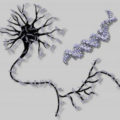
Many neuroscientists and AI researchers believe that truly understanding how the brain works will be impossible until we can fathom how the billions of neurons are connected. Now, researchers at the Salk Institute for Biological Studies believe they have overcome a major hurdle to preparing such a map: identifying all of the connections to a single neuron.
Reporting on their work in Neuron, the researchers describe how they modified the rabies virus, turning it into a tool that can cross the synaptic space of a targeted nerve cell just once to identify all the neurons to which it is directly connected. “We finally found a way to make it possible,” says Salk researcher, Edward M. Callaway. “It will offer us an unprecedented view of the brain.”
Decoding the flow of electrical signals in the complex architecture of the brain is a tricky task, as dozens of different neuronal types are entangled within a precisely connected network, and even neighboring neurons of the same type differ in connectivity and function. Researchers have been trying to decode the pattern of connections typical of a type of neuron, to see which other cell types they connect with and how those connections are configured. To do this, they need a “tracer” that can tease apart the chain of directly connecting neurons, identifying them one by one.
“The core idea is to use a virus that is missing a gene required for spreading across synapses but to provide the missing gene by some other means within the initially infected cells,” says Salk’s Ian Wickersham. With the critical gene deleted from its genome, the virus is marooned inside a cell, unable to spread beyond it. However, supplying the missing gene in that same cell allows the virus to spread to cells that are directly connected to it. Since these neighboring cells lack the gene supplied in the first cell, the virus is stuck. Only the cells connected directly to the original cell are tagged.
The team’s second challenge was to find a way of targeting the viral infection specifically to particular cells, so that the virus could be used to map the connections of cell types of interest or even of single cells. The solution turned out to be an avian viral receptor that the researchers used to replace the protein that ordinarily coats rabies virus particles. This prevented the modified rabies virus from infecting mammalian neurons at all – unless they had been engineered to express the bird virus’s receptor, a bird cell surface protein known as TVA. Such neurons will then appear to be bird cells and the rabies virus – now acting like a bird virus – will infect them.
“The bottom line is that you need two genes expressed in the cell or cell type of interest: TVA, to get the rabies virus in, and the missing viral gene so the virus can spread to connected cells,” says Wickersham.
Experimenting on slices of rat brain, the researchers inserted these two genes into selected neurons – as well as a gene that fluoresces red when expressed. Then they applied the modified rabies virus, which had been given the ability to make infected cells fluoresce green. The result was spectacular: as expected, these red cells were selectively infected by the virus, which spread to hundreds of surrounding cells, turning them brilliantly fluorescent green.
The Salk team says it will be possible to produce transgenic mice that will express specific genes in a targeted class of neurons. “All neurons of the type we select will then express the avian viral receptor and the rabies virus protein, allowing the modified rabies virus to infect targeted cells and spread only once to connecting cells,” explained Callaway. The wiring map can be constructed step by step as subsequent populations of cells are imaged.
Related articles:
A Computer In A Single Neuron
Neurons Mix Digital And Analog Functionality
A Portrait Of The Artist As A Tin Man
Chaotic Neurons Enhance Brain’s Processing








Comments are closed.